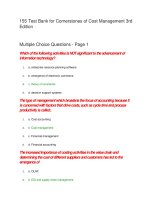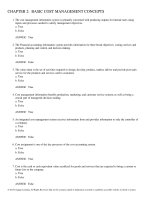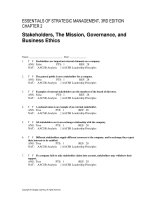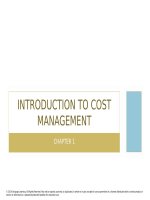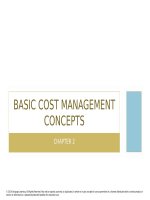Making sense of change management, 3rd edition
Bạn đang xem bản rút gọn của tài liệu. Xem và tải ngay bản đầy đủ của tài liệu tại đây (4.06 MB, 504 trang )
Praise for the previous editions of Making Sense of Change Management
‘I commend it highly. It has a good coverage of relevant theoretical work while at
the same time giving plenty of practical examples. It is written in an accessible
style that engages the reader and it is full of useful ideas without being overly
prescriptive or formulaic.’
Philip Sadler, author of a number of acclaimed business titles and
former chief executive of Ashridge Business School
‘I really enjoyed this book. I like the straightforward approach, the inclusion of the
author’s opinion and the insight provided by the case studies. This book will be
very useful for those business managers in my organization who need to prepare
themselves for tackling major organizational change.’
Andy Houghton, Managing Director of YSC and former Head of
Organization Development, Retail Direct, Royal Bank of Scotland
Group
‘There has long been a need for a readable, practical but theoretically under-pinned
book on Change which recognized a multiplicity of perspectives. By combining
the behavioural, humanistic, organizational and cognitive perspectives and by
helping the reader make sense of what each perspective brings to understanding
Change, this book should help students and practitioners. By linking in work on
personality tests such as MBTI™ the book breaks new ground from a practitioner
point of view not least because these tests are widely used in practice. I thoroughly
recommend it.’
Professor Colin Carnall, Chief Executive, Executive Education, Cass
Business School
‘If you’re interested in successfully managing and leading change, then read this
book! It not only covers change from both the individual and organizational
perspective, but also increases the number of options available to you.’
Judi Billing, former Director of IDeA Leadership Academy, Improvement
and Development Agency
‘Change is a huge thing wherever you work. The key is to make change happen,
and make it happen well – with everyone on side, and everyone happy. This book
i
provides an extremely stimulating and accessible guide to doing just that. There
are a few people at the Beeb who could do with this. I’ll definitely be placing copies
on a couple of desks at White City.’
Nicky Campbell, Presenter Radio Five Live and BBC1’s The Big
Questions
‘This book is a great resource for managers thrown into the midst of change, who
need to gain understanding of what happens when you try to make significant
changes in a business, and how best to manage people through it. The authors
have tackled a complex topic in a lively and engaging way, leading readers
through the maze of theory available and offering just the right amount of practical
advice.’
Andy Newall, Group HR Director United Biscuits and former
Organizational Effectiveness Director, Allied Domecq plc
‘This impressive book on change is an essential read for any professional manager
who is serious about getting to grips with the important issues of making change
happen.’
Dr Jeff Watkins, former MSc Course Director, Management Research
Centre, University of Bristol
‘This practical handbook, combining contemporary management theory with very
practical suggestions, is an indispensable tool for any manager involved in change
processes. And aren’t we all ...’
Adriaan Vollebergh, Director, Tata Steel Europe
‘This is a book which lives up to its title. By combining a guide to the ideas of
key thinkers on change and useful tips for making change happen, it really does
provide a toolkit to help us to make sense of change. It is useful to see a focus on
the individual, team and organizational levels, and in particular, on the role of the
leader in the change process. It is written in a way that makes the book interesting
to read both at length as well as to dip into.’
Dr Richard McBain, Head of Postgraduate Post Experience Programmes,
Henley Business School
ii
MAKING
SENSE OF
CHANGE
MANAGEMENT
iii
THIS PAGE IS INTENTIONALLY LEFT BLANK
iv
MAKING
SENSE OF
CHANGE
MANAGEMENT
A complete guide to the models, tools
and techniques of organizational change
3rd edition
Esther Cameron and Mike Green
v
Publisher’s note
Every possible effort has been made to ensure that the information contained in this book is accurate
at the time of going to press, and the publishers and authors cannot accept responsibility for any
errors or omissions, however caused. No responsibility for loss or damage occasioned to any person
acting, or refraining from action, as a result of the material in this publication can be accepted by
the editor, the publisher or either of the authors.
First published in Great Britain and the United States in 2004 by Kogan Page Limited
Second edition 2009
Third edition 2012
Apart from any fair dealing for the purposes of research or private study, or criticism or review, as
permitted under the Copyright, Designs and Patents Act 1988, this publication may only be reproduced, stored or transmitted, in any form or by any means, with the prior permission in writing of
the publishers, or in the case of reprographic reproduction in accordance with the terms and licences
issued by the CLA. Enquiries concerning reproduction outside these terms should be sent to the
publishers at the undermentioned addresses:
120 Pentonville Road
London N1 9JN
United Kingdom
www.koganpage.com
1518 Walnut Street, Suite 1100
Philadelphia PA 19102
USA
4737/23 Ansari Road
Daryaganj
New Delhi 110002
India
© Esther Cameron and Mike Green, 2004, 2009, 2012
The right of Esther Cameron and Mike Green to be identified as the authors of this work has been
asserted by them in accordance with the Copyright, Designs and Patents Act 1988.
ISBN
978 0 7494 6435 6
E-ISBN 978 0 7494 6436 3
British Library Cataloguing-in-Publication Data
A CIP record for this book is available from the British Library.
Library of Congress Cataloging-in-Publication Data
Cameron, Esther.
Making sense of change management : a complete guide to the models, tools, and techniques of
organizational change / Esther Cameron, Mike Green. – 3rd ed.
p. cm.
Includes bibliographical references and index.
ISBN 978-0-7494-6435-6 – ISBN 978-0-7494-6436-3 1. Organizational change–Management.
2. Teams in the workplace–Management. 3. Reengineering (Management)
4. Information technology–Management. I. Green, Mike, 1959- II. Title.
HD58.8.C317 2012
658.4’06–dc23
2011048827
Typeset by Graphicraft Ltd, Hong Kong
Printed and bound in India by Replika Press Pvt Ltd
vi
Contents
Acknowledgements
xi
Introduction
Who this book is aimed at 2; The basic content of the book 3;
Why explore different approaches to change? 4; Overview of
structure 6; Message to readers 9
1
PART ONE: THE UNDERPINNING THEORY
11
1 Individual change
Introduction 14; Learning and the process of change 16; The
behavioural approach to change 22; The cognitive approach
to change 28; The psychodynamic approach to change 36;
The humanistic psychology approach to change 45;
Personality and change 56; Managing change in self and
others 58; Summary and conclusions 66
14
vii
Contents ____________________________________________________________________
2 Team change
Introduction 69; What is a group and when is it a team? 70;
Why we need teams 72; The types of organizational
teams 73; How to improve team effectiveness 82; What team
change looks like 85; The leadership issues in team
change 91; How individuals affect team dynamics 95; How
well teams initiate and adapt to organizational change 101;
Summary and conclusions 105
69
3 Organizational change
How organizations really work 108; Models of and
approaches to organizational change 119; Summary
and conclusions 147
107
4 Leading change
Introduction 151; Visionary leadership 156; Roles that
leaders play 166; Leadership styles, qualities and skills 174;
Different leadership for different phases of change 184;
The importance of self-knowledge and inner resources 192;
Summary and conclusions 197
151
5 The change agent
Introduction 201; Models of change agency 202;
The consulting process 205; Change agent tools and
frameworks 215; Competencies of the change agent 226;
Deeper aspects of being a change agent 233; Summary and
conclusions 252
201
PART TWO: THE APPLICATIONS
255
Strategic change process 256; Overview of structure 258
6 Restructuring
Reasons for restructuring 263; The restructuring process 264;
Restructuring from an individual change perspective: the
special case of redundancy 285; Enabling teams to address
organizational change 290; Conclusion 296
viii
261
___________________________________________________________________ Contents
7 Mergers and acquisitions
The purpose of merger and acquisition activity 298; Lessons
from research into successful and unsuccessful mergers and
acquisitions 304; Applying the change theory: guidelines for
leaders 319; Summary 332
297
8 Cultural change
Guidelines for achieving successful cultural change 338;
Case study one: aligning the organization 341; Case study
two: rebranding the organization 348; Case study three:
creating an employer brand 356
334
9 IT-based process change
Strategy and IT 365; The role of IT management 369;
The need for IT change managers 373; Achieving process
change 378; Changing the information culture 385;
New rules for a new age 388; Summary and conclusions 389
362
PART THREE: EMERGING INQUIRIES
391
10 Complex change
Introduction 393; When is change complex? 394;
Understanding how complexity science applies to
organizational change 395; Tools that support complex
change 405; The role of leaders in complex change 411;
Summary and conclusions 414
393
11 Leading change in uncertain times
Introduction 416; The impact of uncertainty on our working
lives 418; New organizational forms and ways of doing
business 424; New careers and the need for ‘managing
oneself’ 428; Decision making in an uncertain world 430;
Skills and tools to support leading change through
uncertainty 442; Summary and conclusions 452
416
ix
Contents ____________________________________________________________________
Conclusion
How to get in touch with the authors of this book 456
455
References
Index
457
471
x
Acknowledgements
We want to start by acknowledging the many people in organizations
with whom we have worked over the years. You are all in here in some
shape or form! We have worked with many generous, courageous and
inspiring managers of change who we thank for the privilege of working
alongside them to make real change happen. Without these experiences
the book would be a dry catalogue of theory, devoid of life and character.
Then of course there are our colleagues who challenge and support us
every day as we reflect on our work and make decisions about what to do
next. Particular thanks go from Mike to Andy Holder, Mhairi Cameron,
Philip Darley and Tim Hockridge, who probably do not know how much
they are appreciated, and to Mike’s MBA and Executive Education Pro
gramme Members at Henley Business School for a never-ending supply
of ideas and challenges. Esther wants to specially acknowledge Nick
Mayhew for his encouragement, wisdom and sensitive feedback, particularly in relation to Chapter 11, Anne-Marie Saunders and Alex Clark for
their humour, friendship and generosity in sharing their expertise; so many
of their insights are embedded in this book. Also, thanks go to Esther’s
learning set who really boosted the leadership chapter in particular.
xi
Acknowledgements ___________________________________________________________
Thanks too to Bill Critchley for his ideas on linking metaphor and change,
which form the bedrock of the organizational change chapter.
Really special thanks go to Ailsa Cameron for her wonderful pictures,
which soften the pages so beautifully.
We also want to thank from the bottom of our hearts the hard-working
reviewers who squeezed the time out of their busy agendas to read
draft versions of these chapters. Special thanks go to Louise Overy,
Steve Summers, Duncan Cameron, Mervyn Smallwood, Peter Hyson,
Richard Lacey and Richard Smith for their timely and thoughtful
suggestions throughout the iterative process of writing the book.
Our families have helped too by being very patient and supportive. So
love and thanks from Mike to his children Lewin, Oliver and Brigit, who
make it all worthwhile. Love and thanks too from Esther to Duncan,
Ailsa, Ewan and Katka amongst many others who have walked dogs and
cleaned-up when I’ve had my head in my PC.
We also want to thank each other. We have learnt a lot from this rich
and sometimes rocky process of writing a book together. We do not
always see things the same way, and we do not work from an identical
set of assumptions about change, so the book is the culmination of much
healthy airing of views. Let’s hope we are still writing, talking and enjoying each other’s company many years from now.
Note: The Myers-Briggs Type Indicator™ and MBTI™ are registered trademarks of Consulting Psychologists Press. Anyone interested in knowing
more about Myers-Briggs should contact Consulting Psychologists Press
in the United States (800-624-1765) and OPP in the UK (08708 728 727).
xii
Introduction
I balance on a wishing well that all men call the world.
We are so small between the stars, so large against the sky,
and lost amongst the subway crowd I try and catch your eye.
L Cohen
This book is about making sense of
change management. The world we live
in continues to change at an intense
rate. Not a day goes by, it seems, without another important discovery or
boundary-pushing invention in the
scientific fields. The economics of global
ization seems to dominate much of our
political and corporate thinking, while
the shadow side of globalization – re
fugees, exploitation, terrorism and the like
– develops at an equally alarming pace.
1
Making sense of change management ____________________________________________
The rate of change and discovery outpaces our individual ability to
keep up with it. The organizations we work in or rely on to meet our
needs and wants are also changing dramatically, in terms of their strategies, their structures, their systems, their boundaries and of course their
expectations of their staff and their managers.
WHO THIS BOOK IS AIMED AT
Making Sense of Change Management is aimed at anyone who wants to
begin to understand why change happens, how change happens and
what needs to be done to make change a more welcoming concept. In
particular we hope that leaders and managers in organizations might
appreciate a book that does not give them the one and only panacea, but
offers insights into different frameworks and ways of approaching
change at an individual, team and organizational level.
We are mindful of the tremendous pressures and priorities of prac
tising managers – in both the private and the public sector – and Making
Sense of Change Management is our attempt at making their lives that little
bit easier. It is also our attempt at convincing them that addressing the
issues that cause change to be so poorly managed in organizations will
lead not only to more satisfying experiences for them, but to more fulfilling lives for their staff.
Framework: an essential supporting structure;
Model: a simplified description of a system;
Tool: a thing used in an occupation or pursuit;
Technique: a means of achieving one’s purpose.
Concise Oxford Dictionary
Students of learning – be they MBA or MSc programme members, or
individuals who just want to do things better – will hopefully find some
models, tools and techniques that bridge the gap between the purely
academic and the more pragmatic aspects of management theory and
2
________________________________________________________________ Introduction
practice. The intention is to help them to make sense of the changes that
they will undergo, initiate and implement.
THE BASIC CONTENT OF THE BOOK
We focus our attention on individual, team and organizational change
with good reason. Many readers will be grappling with large-scale change
at some point, which might be departmental, divisional or whole organ
izational change. Whatever the level or degree of organizational change,
the people on the receiving end are individual human beings. It is they
who will ultimately cause the change to be a success or a failure. Without
looking at the implications of change on individuals we can never really
hope to manage large-scale change effectively.
In addition, one of the themes of organizational life over recent years
has been the ascendancy of the team. Much of today’s work is organized
through teams and requires team collaboration and teamworking for it to
succeed. Very little has been written about the role of teams in organizational change, and we have attempted to offer some fresh ideas mixed
with some familiar ones.
A thread running through the book is the crucial role of leadership. If
management is all about delivering on current needs, then leadership is
all about inventing the future. There is a specific chapter on leadership,
but you will find the importance of effective leadership arising throughout.
In some respects the chapters on individual, team and organizational
change, together with the chapter on leadership of change, are freestanding and self-contained. However, we have also included application
chapters where we have chosen a number of types of change, some of
which, no doubt, will be familiar to you. These chapters aim to provide
guidelines, case studies and learning points for those facing specific
organizational challenges. Here the individual, team and organizational
aspects of the changes are integrated into a coherent whole.
In addition to the application chapter on managing complex change
that we added for the second edition, we have added two new chapters
for the third edition – one on the role and nature of the change agent and
another on leading change in uncertain times.
3
Making sense of change management ____________________________________________
WHY EXPLORE DIFFERENT APPROACHES TO CHANGE?
Managers in today’s organizations face some bewildering challenges.
Paul Evans (2000) says that 21st century leadership of change issues is not
simple; he sees modern leadership as a balancing act. He draws our attention to the need for leaders to accept the challenge of navigating between
opposites. Leaders have to balance a track record of success with the
ability to admit mistakes and meet failure well. They also have to balance
short-term and long-term goals, be both visionary and pragmatic, pay
attention to global and local issues and encourage individual account
ability at the same time as enabling team work.
It is useful to note that while some pundits encourage leaders to lead
rather than manage, Paul Evans is emphasizing the need for leaders to
pay attention to both management and leadership. See the box for a list
of paradoxes that managers at Lego are asked to manage.
THE 11 PARADOXES OF LEADERSHIP THAT HANG
ON THE WALL OF EVERY LEGO MANAGER
• To be able to build a close relationship with one’s staff, and to keep a
suitable distance.
• To be able to lead, and to hold oneself in the background.
• To trust one’s staff, and to keep an eye on what is happening.
• To be tolerant, and to know how you want things to function.
• To keep the goals of one’s department in mind, and at the same time
to be loyal to the whole firm.
• To do a good job of planning your own time, and to be flexible with your
schedule.
• To freely express your view, and to be diplomatic.
• To be a visionary, and to keep one’s feet on the ground.
• To try to win consensus, and to be able to cut through.
• To be dynamic, and to be reflective.
• To be sure of yourself, and to be humble.
Source: Evans (2000)
4
________________________________________________________________ Introduction
We believe that anyone interested in the successful management of
change needs to develop the ability to handle such paradoxes. Throughout
this book we offer a range of ideas and views, some of which are contradictory. We would urge you to try to create a space within yourself for
considering a variety of perspectives. Allow your own ideas and insights
to emerge, rather than looking for ideas that you agree with, and discarding those you do not care for. It is highly probable that there is some merit
in everything you read in this book!
With so many choices and so many dynamic tensions in leadership,
how does a manager learn to navigate his or her way through the maze?
We have developed a straightforward model of leadership that acts as a
strong reminder to managers that they need to balance three key dimensions; see Figure 0.1.
Figure 0.1 Three dimensions of leadership
Source: developed by Mike Green, Andy Holder and Mhairi Cameron
5
Making sense of change management ____________________________________________
Managers usually learn to focus on outcomes and tangible results very
early on in their careers. This book is a reminder that although outcomes
are extremely important, the leader must also pay attention to underlying
emotions, and to the world of power and influence, in order to sustain
change and achieve continued success in the long term. Leaders of
change need to balance their efforts across all three dimensions of an
organizational change:
• outcomes: developing and delivering clear outcomes;
• interests: mobilizing influence, authority and power;
• emotions: enabling people and culture to adapt.
Leaders are at the centre of all three. They shape, direct and juggle them.
One dimension may seem central at any time: for example, developing a
strategy. However, leadership is about ensuring that the other dimensions
are also kept in view. The three balls must always be juggled successfully.
In our experience, if you as leader or manager of change are unaware
of what is happening (or not happening) in each of the three dimensions,
you will have ‘taken your eye off the ball’. Your chances of progressing in
an effective way are diminished.
The early chapters of this book give the reader some underpinning
theory and examples to illustrate how people initiate change and react
to change at an individual level, when in teams, or when viewed as part
of a whole organization. This theory will help managers to understand
what is going on, how to deal with it and how to lead it with the help
of others. The later chapters take real change situations and give specific
tips and guidelines on how to tackle these successfully from a leadership
point of view.
OVERVIEW OF STRUCTURE
We have structured the book principally in three parts.
Part One, ‘The underpinning theory’, comprises five chapters and aims
to set out a wide range of ideas and approaches to managing change.
6
________________________________________________________________ Introduction
Chapter 11
Chapter 10
Introduction Part Three
x
x
xxx x
x
xx
x
x
x
x
xx
xx
xx
xx
xx
x
x
x
Leading change x
x
x
x
xxx xx
x
Uncertainty
x
Complex change
IT process
x
xxx x
Chapter 9
Culture
xx
x
Chapter 8
M&A
x
x
Chapter 7
Restructuring
x
Organizational x
Chapter 6
Chapter 5
Change agent
Introduction to Part Two
Chapter 4
Leading change
xxx
Chapter 3
Chapter 2
Team
Individual
Team
Organizational
Chapter 1
Type of change
Individual
Introduction
Table 0.1 Where to read about individual, team,
organizational change and leading change
xx xx
xx
Chapter 1 draws together the key theories of how individuals go through
change. Chapter 2 compares different types of team, and examines the
process of team development and also the way in which different types
of team contribute to the organizational change process. Chapter 3 looks
at a wide range of approaches to organizational change, using organizational metaphor to show how these are interconnected and related.
Chapter 4 examines leadership of change, the role of visionary leadership,
the roles that leaders play in the change process and the competencies
that a leader needs to become a successful leader of change. Chapter 5
looks at the critical role and nature of the agent of change, both from a
competency perspective and also from the use of the self as an instrument
for change.
7
Making sense of change management ____________________________________________
These chapters enable the reader to develop a broader understanding
of the theoretical aspects of individual, team and organizational change,
and to learn more about a variety of perspectives on how best to be a
leader of change. This lays firm foundations for anyone wanting to learn
about new approaches to managing change with a view to becoming
more skilled in this area.
Part Two, ‘The applications’, focuses on specific change scenarios with
a view to giving guidelines, hints and tips to those involved in these
different types of change process. These chapters are illustrated with case
studies and make reference to the models and methods discussed in Part
One. Chapter 6 looks at organizational restructuring, why it goes wrong,
and how to get it right. Chapter 7 tackles mergers and acquisitions by
categorizing the different types of activity and examining the learning
points resulting from research into this area. Chapter 8 examines cultural
change by describing some diverse case studies and extracting the learning points, and Chapter 9 attempts to shed some light on IT-based process
change, why it so often goes awry and what organizations can do to
improve on this.
One of the clear things that has emerged for us in helping others lead
and manage change is the tension between overly planning and controlling change on the one hand, and the fact that change is often not simple
enough to plan or control on the other. In Part Three, Chapter 10 looks
at the whole area of complexity science and how it can inform your
approach when managing complex change. Chapter 11 looks at leading
change in times of uncertainty.
Please do not read this book from beginning to end in one sitting. It is
too much to take in. We recommend that if you prefer a purely pragmatic
approach you should start by reading Part Two. You will find concrete
examples and helpful guidelines. After that, you might like to go back
into the theory in Part One to understand the choices available to you as
a leader of change.
Likewise, if you are more interested in understanding the theoretical
underpinning of change, then read Part One first. You will find a range
of approaches together with their associated theories of change. After
that, you might like to read Part Two to find out how the theory can be
applied in real situations.
8
________________________________________________________________ Introduction
MESSAGE TO READERS
We wish you well in all your endeavours to initiate, adapt to and survive
change. We hope the book provides you with some useful ideas and
insights, and we look forward to hearing about your models, approaches
and experiences, and to your thoughts on the glaring gaps in this book.
We are sure we have left lots of important things out!
Do e-mail us with your comments and ideas, or visit us at:
Esther:
Website:
E-mail:
Mike:
Website: www.transitionalspace.co.uk
E-mail:
9
THIS PAGE IS INTENTIONALLY LEFT BLANK
10
Part One
The underpinning
theory
All appears to change when we change.
Henri Amiel
Individual change is at the heart of everything that is achieved in organ
izations. Once individuals have the motivation to do something different,
the whole world can begin to change. The conspiracy laws in the UK
recognize this capacity for big change to start small. In some legal cases,
the merest nod or a wink between two people seems to be considered
adequate evidence to indicate a conspiratorial act. In some respects this
type of law indicates the incredible power that individuals have within
them to challenge existing power strongholds and alter the way things
are done.
However, individuals are to some extent governed by the norms of the
groups they belong to, and groups are bound together in a whole system
of groups of people that interconnect in various habitual ways. So the
11
The underpinning theory _______________________________________________________
story is not always that simple. Individuals, teams and organizations all
play a part in the process of change, and leaders have a particularly onerous
responsibility: that is, making all this happen.
We divided this book into three parts so that readers could have the
option either to start their journey through this book by first reading
about the theory of change, or to begin by reading about the practical
applications. We understand that people have different preferences.
However, we do think that a thorough grounding in the theory is useful
to help each person to untangle and articulate his or her own assumptions about how organizations work and how change occurs. Do you, for
instance, think that organizations can be changed by those in leadership
positions to reach a predetermined end state, or do you think that people
in organizations need to be collectively aware of the need for change
before they can begin to adapt? Assumptions can be dangerous things
when not explored, as they can restrict your thinking and narrow down
your options.
Part One comprises five chapters. These have been chosen to represent
five useful perspectives on change: individual change, team change,
organizational change, leading change and the role of the change agent.
Chapter 1 draws together the four key approaches to understanding individual change. These are the behavioural, cognitive, psychodynamic and
humanistic psychology approaches. This chapter also looks at the connection between personality and change, and how to enable change in others
when you are acting in a managerial role.
Chapter 2 identifies the main elements of team and group theory that
we believe are useful to understand when managing change. This chapter compares different types of team, looks at the area of team effectiveness, and examines the process of team development. The composition of
the team and the effect this has on team performance are also examined,
as well as the way in which different types of team contribute to the
organizational change process.
Chapter 3 looks at a wide range of approaches to organizational
change, using organizational metaphor to show how these are interconnected and related. Familiar and unfamiliar models of the change process
are described and categorized by metaphor to enable the underpinning
12
______________________________________________________ The underpinning theory
assumptions to be examined, and we give our views on how useful these
various models are to leaders of change.
Chapter 4 examines the leadership of change. We start by looking at the
variety of leadership roles that arise from using different assumptions
about how organizations work. The need for visionary leadership, the
characteristics of successful leaders and some thoughts on the need for a
different sort of leadership in the 21st century are all aired. The chapter
also examines how communities of leaders can work together to make
change happen, and what styles and skills are required of a leader,
including the need for emotional competencies. The phases of a change
process are looked at in order to illuminate the need for different leadership actions and attention during the different phases of change, and the
importance of self-knowledge and self-awareness is highlighted.
Chapter 5 looks at the role of the change agent, highlighting areas
of competence needed and exploring the unique role that the agent of
change plays in the change process, particularly what is going on inside
for them; how they can use that to great effect; and how they might
need help in the change process itself.
13




